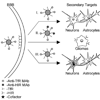Blood-brain barrier transport of therapeutics via receptor-mediation
- PMID: 17619996
- PMCID: PMC2685177
- DOI: 10.1007/s11095-007-9379-0
Blood-brain barrier transport of therapeutics via receptor-mediation
Abstract
Drug delivery to the brain is hindered by the presence of the blood-brain barrier (BBB). Although the BBB restricts the passage of many substances, it is actually selectively permeable to nutrients necessary for healthy brain function. To accomplish the task of nutrient transport, the brain endothelium is endowed with a diverse collection of molecular transport systems. One such class of transport system, known as a receptor-mediated transcytosis (RMT), employs the vesicular trafficking machinery of the endothelium to transport substrates between blood and brain. If appropriately targeted, RMT systems can also be used to shuttle a wide range of therapeutics into the brain in a noninvasive manner. Over the last decade, there have been significant developments in the arena of RMT-based brain drug transport, and this review will focus on those approaches that have been validated in an in vivo setting.
Figures



References
-
- Pardridge WM. Molecular Trojan horses for blood-brain barrier drug delivery. Curr Opin Pharmacol. 2006;6:494–500. - PubMed
-
- Pardridge WM. Brain Drug Targeting; the Future of Brain Drug Development. Cambridge UK: Cambridge University Press; 2001.
-
- Bickel U, Yoshikawa T, Pardridge WM. Delivery of peptides and proteins through the blood-brain barrier. Adv Drug Delivery Rev. 2001;46:247–279. - PubMed
-
- Jefferies WA, Brandon MR, Hunt SV, Williams AF, Gatter KC, Mason DY. Transferrin receptor on endothelium of brain capillaries. Nature. 1984;312:162–163. - PubMed
-
- Duffy KR, Pardridge WM. Blood-brain barrier transcytosis of insulin in developing rabbits. Brain Res. 1987;420:32–38. - PubMed
Publication types
MeSH terms
Substances
Grants and funding
LinkOut - more resources
Full Text Sources
Other Literature Sources

